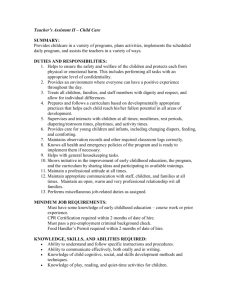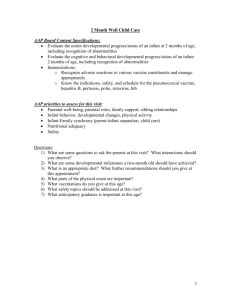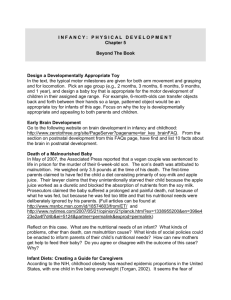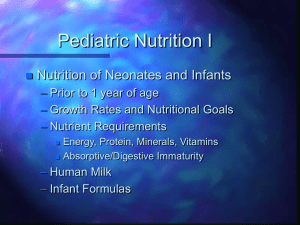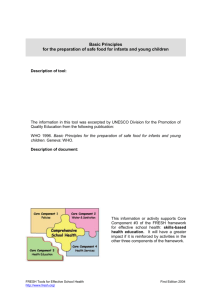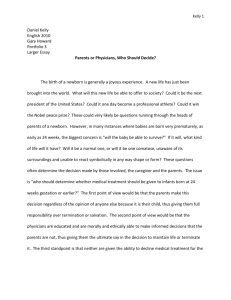Provide a Nutritionally Sound Early Childhood Program
advertisement
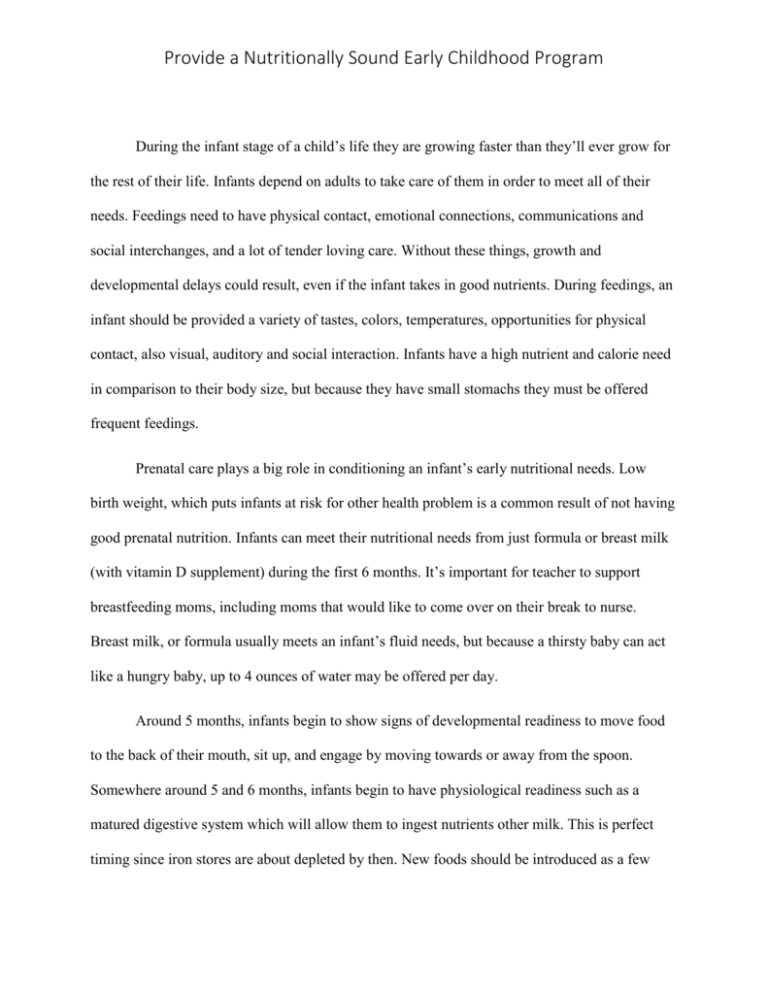
Provide a Nutritionally Sound Early Childhood Program During the infant stage of a child’s life they are growing faster than they’ll ever grow for the rest of their life. Infants depend on adults to take care of them in order to meet all of their needs. Feedings need to have physical contact, emotional connections, communications and social interchanges, and a lot of tender loving care. Without these things, growth and developmental delays could result, even if the infant takes in good nutrients. During feedings, an infant should be provided a variety of tastes, colors, temperatures, opportunities for physical contact, also visual, auditory and social interaction. Infants have a high nutrient and calorie need in comparison to their body size, but because they have small stomachs they must be offered frequent feedings. Prenatal care plays a big role in conditioning an infant’s early nutritional needs. Low birth weight, which puts infants at risk for other health problem is a common result of not having good prenatal nutrition. Infants can meet their nutritional needs from just formula or breast milk (with vitamin D supplement) during the first 6 months. It’s important for teacher to support breastfeeding moms, including moms that would like to come over on their break to nurse. Breast milk, or formula usually meets an infant’s fluid needs, but because a thirsty baby can act like a hungry baby, up to 4 ounces of water may be offered per day. Around 5 months, infants begin to show signs of developmental readiness to move food to the back of their mouth, sit up, and engage by moving towards or away from the spoon. Somewhere around 5 and 6 months, infants begin to have physiological readiness such as a matured digestive system which will allow them to ingest nutrients other milk. This is perfect timing since iron stores are about depleted by then. New foods should be introduced as a few Provide a Nutritionally Sound Early Childhood Program baby spoonfuls once to twice daily. Iron-fortified infant cereals, less likely to cause allergic reactions and can easily be thinned as needed is usually the first food introduced. With many infants having special needs being enrolled in early childhood programs, teachers need to work with families to best understand the child’s condition, medical treatments, nutritional needs, and how they can work together for the infant’s healthy development. A runny nose, diarrhea, constipation, bloating, vomiting, hives, and eczema are all possible allergic response symptoms. Food allergies or sensitivities, overfeeding, infections (systemic or food-borne), eating food the baby isn’t ready for, poor formula preparation, use of fruit juice, swallowed air, and acid reflux are all typical reasons for vomiting and diarrhea in infants. Putting infants to sleep with formula, breast milk, or juices are at a higher risk of tooth decay. Cleaning gums before they go down to sleep and weaning to a cup around 8 months with help prevent this. Propping bottles may result in an ear infection, and choking. It’s believed that overeating during baby feedings, introduction of semi-solid foods too early, feeding cereal from a bottle may lead to infant obesity. During teething, appropriate toys and food should be readily available to sooth infants and discourage them from chewing on other things while keeping in mind to have toys frequently sanitized. As toddlers start to assert their independence they may be neophobic and not want to try new foods. To help meal times run more smoothly there needs to be respect in the adult and child responsibilities. Adult’s responsibilities are deciding when to offer a variety of nutritious foods, and setting a good example on eating habits. The child’s responsibilities include deciding how much of which foods offered will be eaten. Provide a Nutritionally Sound Early Childhood Program Serving slightly less than what a toddler’s serving should be will make the food look less overwhelming and allow them the independence they crave to ask for more. Forewarning and good flexible planning will help find the best time to serve toddlers. Good hand washing practice, and child-sized furniture, cups, plates, and utensil help make mealtime safe, comfortable, and pleasant. Gardening and helping to prepare food will increase a child’s interest. Children consuming large quantities of milk and eating little to nothing are likely to have nutrient deficiencies. There are a few different reasons that a child may refuse food. If there isn’t a medical reason then it’s best to not give into them wanting other things, but not to make a big deal out of it either. Always serving a different variety of nutritious foods will help prevent food jags. It’s important for the teacher and family to be on the same page, and be consistent with strategies in order to successfully implement a strategy. There are many things that need to be considered when planning meals for children 1. Nutritious needs 2. Funding and licensing requirements 3. Sensory appeal 4. Comfort with familiar foods 5. Introducing new foods to encourage healthy habits 6. Serving safe food in clean surroundings 7. Keeping in the budget 8. Children who have food allergies, eating problems, and special nutritional needs are provided alternative food Provide a Nutritionally Sound Early Childhood Program The following materials should be on hand when planning a menu: 1. Menu form 2. List of foods that need to be used 3. List of any children’s allergies 4. Recipes 5. Old menus 6. Calendar listing special events and holidays 7. Grocery ad 8. USDA list of available commodity foods White and warm colored plates make food look more appealing. Plate service and familystyle service each offer their own great advantages; therefore, a teacher could try a combination of the two. Food should be made while keeping in mind safety, nutrition, and waste management of food. Over the years there has been an increasing amount of children relying on teachers to educate and guide children about nutrition; therefore, teachers need to have a good understanding of the basic nutrients, and be able to create healthy menus in a creatively, appealing way. It is also important for teachers to role model, use cultural sensitivity, work with families, and provide education and supervision in order for teachers to improve the health environment of young children.
